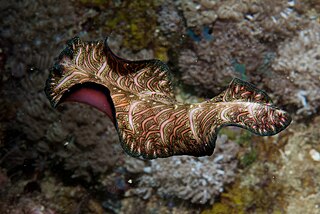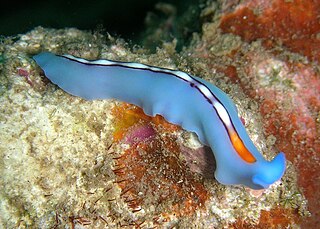
The flatworms, flat worms, Platyhelminthes, or platyhelminths are a phylum of relatively simple bilaterian, unsegmented, soft-bodied invertebrates. Unlike other bilaterians, they are acoelomates, and have no specialised circulatory and respiratory organs, which restricts them to having flattened shapes that allow oxygen and nutrients to pass through their bodies by diffusion. The digestive cavity has only one opening for both ingestion and egestion ; as a result, the food cannot be processed continuously.

The 1750s was a decade of the Gregorian calendar that began on January 1, 1750, and ended on December 31, 1759. The 1750s was a pioneering decade. Waves of settlers flooded the New World in hopes of re-establishing life away from European control, and electricity was a field of novelty that had yet to be merged with the studies of chemistry and engineering. Numerous discoveries of the 1750s forged the basis for contemporary scientific consensus. The decade saw the end of the Baroque period.

Androgen insensitivity syndrome (AIS) is a difference in sex development involving hormonal resistance due to androgen receptor dysfunction.

John is a common male given name in the English language ultimately of Hebrew origin. The English form is from Middle English Ion, Ihon, Jon, Jan (mid-12c.), itself from Old French Jan, Jean, Jehan, from Medieval Latin Johannes, altered form of Late Latin Ioannes, or the Middle English personal name is directly from Medieval Latin, which is from the Greek name Ioannis (Ιωάννης), originally borne by Hellenized Jews transliterating the Hebrew name Yochanan, the contracted form of the longer name Yehochanan, meaning "Yahweh is Gracious" or "Yahweh is Merciful". There are numerous forms of the name in different languages; these were formerly often simply translated as "John" in English, but are increasingly left in their native forms.

Myrmecia is a genus of ants first established by Danish zoologist Johan Christian Fabricius in 1804. The genus is a member of the subfamily Myrmeciinae of the family Formicidae. Myrmecia is a large genus of ants, comprising at least 93 species that are found throughout Australia and its coastal islands, while a single species is only known from New Caledonia. One species has been introduced out of its natural distribution and was found in New Zealand in 1940, but the ant was last seen in 1981. These ants are commonly known as bull ants, bulldog ants or jack jumper ants, and are also associated with many other common names. They are characterized by their extreme aggressiveness, ferocity, and painful stings. Some species are known for the jumping behavior they exhibit when agitated.

Animal sexual behaviour takes many different forms, including within the same species. Common mating or reproductively motivated systems include monogamy, polygyny, polyandry, polygamy and promiscuity. Other sexual behaviour may be reproductively motivated or non-reproductively motivated.

Dugesia is a genus of dugesiid triclads that contains some common representatives of the class Turbellaria. These common flatworms are found in freshwater habitats of Africa, Eurasia, and Australia. Dugesia is best known to non-specialists because of its regeneration capacities.

Pseudocerotidae is a family of flatworms which includes the Bedford's flatworm. Pseudocerotidae are simple organisms categorized by their oval bodies and tentacles and bright colors. They use the cilia to glide along surfaces. Most commonly referred to as marine flatworms, closely related to the orders Macrostomorpha and Lecithoepitheliata. These organisms have very complex reproductive systems, no blood systems or organs for gas exchange, a simple brain and are hermaphroditic.

Pseudoceros is a genus of the flatworms Platyhelminthes.

A penis is the primary sexual organ that male animals use to inseminate females during copulation. Such organs occur in many animals, both vertebrate and invertebrate, but males do not bear a penis in every animal species. Furthermore, penises are not necessarily homologous.

Pseudobiceros hancockanus is a species of hermaphroditic marine flatworm in the family Pseudocerotidae. It is also known as Hancock's Flatworm.

Chromodoris is a genus of very colourful sea slugs or dorid nudibranchs, marine gastropod molluscs, and the type genus of the family Chromodorididae. Within the genus Chromodoris, there are currently 101 classified species. Species within Chromodoris are commonly found in tropical and subtropical waters, living as members of reef communities and preying primarily on sponges. A molecular phylogeny of the family Chromodorididae resulted in this genus being restricted to a smaller number of species than formerly, most of which have longitudinal black lines on the mantle. Many former members of Chromodoris were transferred to Goniobranchus
Macrostomum is a genus of flatworm with a worldwide distribution, with over a hundred species described to date. These hermaphroditic, free-living flatworms are usually small in size, with large species reaching up to 5 mm in body length. They are usually transparent, and the smaller species appear rather round in cross-section than dorsoventrally flattened.

Pseudobiceros bedfordi is a species of flatworm in the family Pseudocerotidae.

Acanthozoon is a genus of polyclad flatworms belonging to the family Pseudocerotidae.

Pseudobiceros fulgor, also known the lightning worm, is a species of marine flatworm from the family Pseudocerotidae and belongs to the class Turbellaria. These flatworms are commonly found in the tropics of the Indo-Pacific region. They can be found in shallow coral reef environments.


























